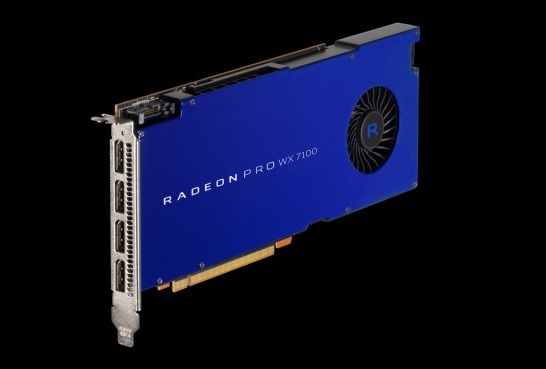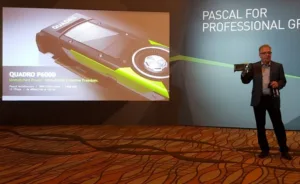Computer graphics event Siggraph is ongoing at the time of writing, and several announcements have been made by both AMD and Nvidia. Unlike previous years, virtual reality was a focus of the 2016 show.
AMD showed off three new workstation graphics cards – the first significant update to the lineup since 2014. The WX 7100, WX5100 and WX 4100 are part of AMD’s Radeon Pro QX family, powered by the Polaris GPU series. They use Polaris 10 and Polaris 11 GPUs, and are aimed at the sub-$1,000 market. They will be launched in Q4.
 The WX 7100 is the top-of-the-range mode, with the Polaris 10 GPU. It will have 2,304 stream processors, much like the RX 480 consumer graphics card. Clock speeds have not been revealed. However, Anandtech believes that, given AMD’s 5 TFLOPS minimum, it will be no lower than 1.08GHz. The card has 8GB of GDDR5 VRAM on a 256-bit bus (although the Polaris 10 can support up to 16GB). The WX 7100 is a single-slot card with four DisplayPort 1.4 outputs.
The WX 7100 is the top-of-the-range mode, with the Polaris 10 GPU. It will have 2,304 stream processors, much like the RX 480 consumer graphics card. Clock speeds have not been revealed. However, Anandtech believes that, given AMD’s 5 TFLOPS minimum, it will be no lower than 1.08GHz. The card has 8GB of GDDR5 VRAM on a 256-bit bus (although the Polaris 10 can support up to 16GB). The WX 7100 is a single-slot card with four DisplayPort 1.4 outputs.
Next is the WX 5100, which also uses the Polaris 10. It has 1,792 stream processors (more than double the preceding W5100) and a clock speed of at least 1.2GHz. VRAM is the same as the WX 7100. Finally is the WX 4100, which replaces the W4300. It uses the Polaris 11 GPU, which is said to be ‘aggressively’ power optimised. The GPU has 1,024 stream processors, clocked at ‘no less’ than 975MHz. The card has 4GB of GDDR5 VRAM on a 128-bit bus. It has four mini-DisplayPort interfaces.
Each of the cards supports DisplayPort 1.4, meaning that they can drive 5k displays: up to four per card. They also support HDR and HDR metadata. HDMI 2.0b is also supported. The Polaris architecture additionally is the first to support AMD’s new encode/decode block: the first time that HEVC has been available on a FirePro workstation card.
AMD also spoke about Project Loom, a real-time 360° video stitching tool for professional users. The tool can pull in up to 24 camera feeds at 1080/60, stitching and outputting the resulting 360° video in UltraHD at 30fps.
It wasn’t only AMD working on stitching, though. Nvidia announced its own SDK called VRWorks 360 Video, which – like Project Loom – can capture and stitch in real-time. VRWorks 360 works with the company’s newest Quadro graphics cards, with feeds from up to 32 cameras.
As for those new cards, Nvidia also showed two additions to the Quadro range: the P6000 and P5000. The P6000 is the top-of-the-line unit. It is based on the Pascal architecture and the same chassis as the Geforce GTX 1080/1070/1060 consumer cards. However, it also has 24GB of VRAM, 3,840 CUDA cores and a TDP of 250W. Processing power reaches 12 TFLOPs. The step-down P5000 has 16GB of VRAM and 2,560 CUDA cores, with 8.9 TFLOPs of power. Both feature DisplayPort 1.4 (x4) and DVI-D ports.
The Quadro cards will be shipped in October. Although Nvidia hasn’t announced pricing yet, expect them to be significantly more expensive than AMD’s WX cards.

